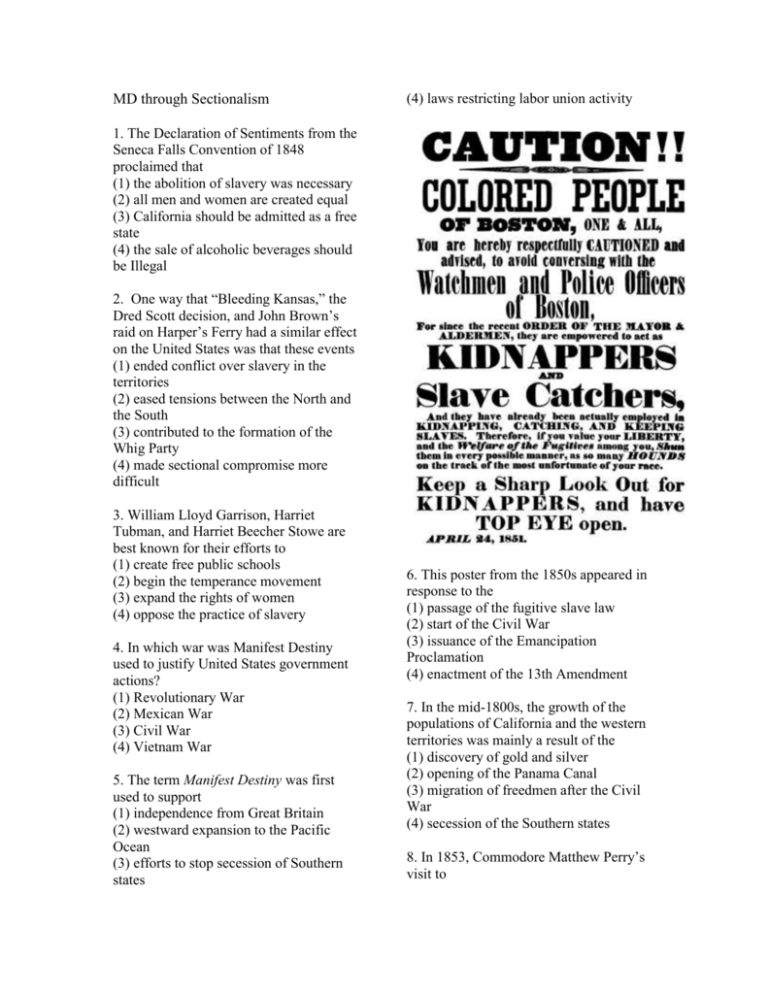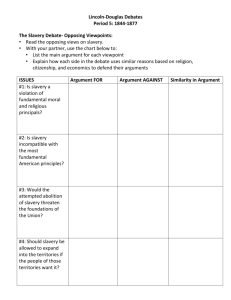MD through Sectionalism - Hicksville Public Schools / Homepage
advertisement

MD through Sectionalism (4) laws restricting labor union activity 1. The Declaration of Sentiments from the Seneca Falls Convention of 1848 proclaimed that (1) the abolition of slavery was necessary (2) all men and women are created equal (3) California should be admitted as a free state (4) the sale of alcoholic beverages should be Illegal 2. One way that “Bleeding Kansas,” the Dred Scott decision, and John Brown’s raid on Harper’s Ferry had a similar effect on the United States was that these events (1) ended conflict over slavery in the territories (2) eased tensions between the North and the South (3) contributed to the formation of the Whig Party (4) made sectional compromise more difficult 3. William Lloyd Garrison, Harriet Tubman, and Harriet Beecher Stowe are best known for their efforts to (1) create free public schools (2) begin the temperance movement (3) expand the rights of women (4) oppose the practice of slavery 4. In which war was Manifest Destiny used to justify United States government actions? (1) Revolutionary War (2) Mexican War (3) Civil War (4) Vietnam War 5. The term Manifest Destiny was first used to support (1) independence from Great Britain (2) westward expansion to the Pacific Ocean (3) efforts to stop secession of Southern states 6. This poster from the 1850s appeared in response to the (1) passage of the fugitive slave law (2) start of the Civil War (3) issuance of the Emancipation Proclamation (4) enactment of the 13th Amendment 7. In the mid-1800s, the growth of the populations of California and the western territories was mainly a result of the (1) discovery of gold and silver (2) opening of the Panama Canal (3) migration of freedmen after the Civil War (4) secession of the Southern states 8. In 1853, Commodore Matthew Perry’s visit to Japan was important to the United States because it (1) ended the United States policy of neutrality (2) opened new trading opportunities in Asia (3) began a military alliance between the two nations (4) acquired cheap labor for America’s factories 9. As a result of President Andrew Jackson’s policies, Native American Indians were (1) relocated to reservations in Mexico (2) forcibly removed to areas west of the Mississippi River (3) gradually allowed to return to their ancestral lands (4) given United States citizenship 10. The Missouri Compromise (1820), the Compromise of 1850, and the Kansas-Nebraska Act (1854) were all efforts to (1) end fighting between midwestern farmers and Native American Indians (2) encourage manufacturing in the West (3) increase the number of people who voted in presidential elections (4) settle disputes over the spread of slavery to the western territories 11. The institution of slavery was formally abolished in the United States by the (1) Compromise of 1850 (2) Emancipation Proclamation of 1863 (3) creation of the Freedmen’s Bureau in 1865 (4) ratification of the 13th amendment in 1865 12. In an outline, which main topic would include the other three? (1) Erie Canal (2) 19th-Century Internal Improvements (3) Transcontinental Railroad (4) National Road 13. Which term did Americans use in the 1840s to describe the idea that the United States should possess the entire continent? (1) containment (2) globalization (3) Manifest Destiny (4) popular sovereignty 14. During the 1840s, abolitionists opposed annexation of new western territory because they (1) feared the admission of new slave states (2) wanted to limit the power of the national government (3) were concerned with the legal rights of Native American Indians (4) supported an isolationist foreign policy 15. The annexation of Texas and the Mexican Cession are best described as efforts by the United States to (1) remove European threats (2) limit the spread of slavery (3) end wars of aggression (4) fulfill Manifest Destiny 16. The Seneca Falls Convention of 1848 is often viewed as the beginning of the (1) temperance movement (2) women’s rights movement (3) antislavery movement (4) Native American Indian movement 17. “. . . Liberty and Union, now and forever, one and inseparable!” — Daniel Webster, 1830 The principle expressed in this statement was also reflected in (1) Thomas Jefferson’s call for nullification of the Alien and Sedition Acts (2) Federalist Party threats during the War of 1812 (3) John Calhoun’s defense of States rights (4) Abraham Lincoln’s attitude toward Southern secession 18. From 1820 to 1865, the debates over nullification, protective tariffs, and the spread of slavery into the new territories concerned the constitutional issue of the (1) balance of power between the federal and state governments (2) balance between the rights of individuals and the need to maintain order (3) protection of the rights of ethnic and racial groups (4) separation of power between the executive and legislative branches 19. During the presidency of Andrew Jackson, the spoils system resulted in (1) federal laws being nullified by the states (2) elected officials rewarding their supporters with government jobs (3) all free males being given the right to vote (4) the end of political corruption in the federal Government 20. The Seneca Falls Convention of 1848 was mainly concerned with (1) ending slavery in all the states (2) reducing consumption of alcoholic beverages (3) improving treatment of the mentally ill (4) expanding women’s rights 21. Which heading best completes the partial outline below? I._________________________________ ___ A. Nullification crisis B. Kansas-Nebraska Act C. Dred Scott v. Sanford D. Election of Lincoln (1860) (1) Foreign Policies of the United States (2) Government Policies Toward Native American Indians (3) Consequences of Manifest Destiny (4) Causes of Sectional Conflict 22. In the Compromise of 1850 and the Kansas- Nebraska Act of 1854, popular sovereignty was proposed as a way to (1) allow northern states the power to ban slavery (2) deny southern states the legal right to own slaves (3) allow settlers in new territories to vote on the issue of slavery (4) overturn previous Supreme Court decisions on slavery 23. Which title best completes the partial outline below? I. __________________________________ A. California Gold Rush (1849) B. Homestead Act (1862) C. Completion of transcontinental railroad (1869) (1) Factors Encouraging Westward Settlement (2) Government-Sponsored Transportation Programs (3) Recognition of Native American Indian Land Rights (4) Actions Promoting the Conservation of Natural Resources 24. In the 1840s, President James K. Polk’s belief in Manifest Destiny led to (1) a war with Mexico (2) an alliance with several South American nations (3) the establishment of new colonies in the Caribbean (4) a ban on the activities of northern abolitionists 25. The principle of popular sovereignty was an important part of the (1) Indian Removal Act (3) Homestead Act (2) Kansas-Nebraska Act (4) Dawes Act







